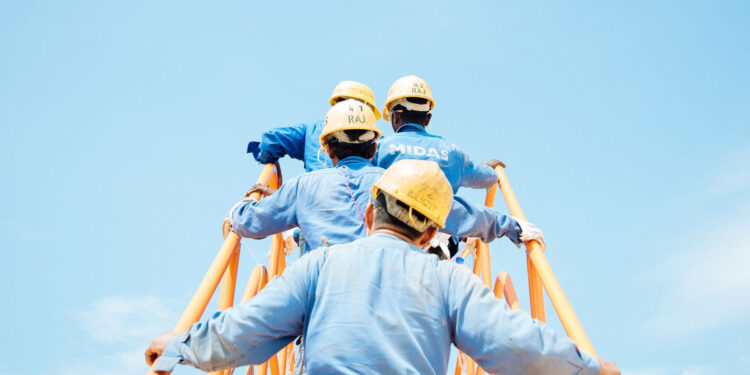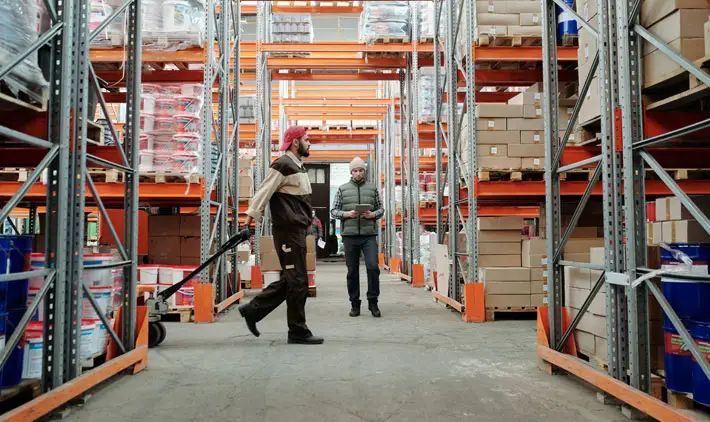65,427 Non-Fatal Work-Related Injuries Reported in the UK by Employers in 2019/20 – What Causes So Many Accidents in the Workplace?

Work accidents are commonplace in the UK. Even if employers offer training, risk assessments and hire dedicated workers to supervise the operations and reduce the number of accidents, employees still get injured. For 2019/20, employers reported 65,427 non-fatal employee injuries. However, the number of self-reported non-fatal injuries exceed over ten times; the Labour Force Survey reveals 693,000 were injured at work (168,000 victims with over 7 days absence, and 525,000 victims with up to 7 days absence).
Work-related accidents caused 28.2 million working days lost only in 2019, so it’s understandable why everyone tries to figure out what leads to these accidents to be able to prevent them. This article provides a list of the most common work-related accident causes. Let’s have a look.
Trips, slips, and falls
Trips, slips, and falls are the most common causes of work accidents worldwide. Statistics report that slipping and tripping are prevalent sources of major injuries in English workplaces, and they often trigger other accidents attributed to factors like falls from height, scalding, and machinery. 29% of the non-fatal injuries workers had in 2019/20 resulted from slips, trips, or falls on the same level. The good news is that this cause doesn’t lead to serious injuries, even if it is the greatest reason workers are off work. Slipping on a wet floor often leads to fractured bones. The best way to prevent slips, trips, and falls is to ensure that spillages are dealt with immediately and the floors are slip-proof. Employers should also offer their workers suitable footwear when they operate in areas with a high slip or trip area. They can also hire a team to secure the workplace and ensure there are no obstacles on walkways that can cause accidents.
Poor manual handling
Manual handling accidents account for a large number of accidents annually. Most times, people who suffer from these accidents have to miss work for more than 7 days because the recovery is longer than for trips, slips, and falls. Handling accidents are quite hurtful for the employee’s long-time health because it directly impacts their work performance. People often experience strains or damage to the neck, spine, or back when involved in this kind of accident. Spinal injuries are associated with a permanent effect on movement and require physiotherapy and medication. It’s common for workers who experience spinal injuries to retire because they can no longer perform the manual tasks their jobs require.
Employees usually get spinal injuries when they don’t receive proper training on how to lift and carry items or when the employer overburdens them by asking them to move something heavier than allowed. Companies should use machines or apparatus to handle heavy loads and avoid accident-related injuries.
Electrical accidents
Everyone should know how dangerous electricity is for one’s health. Statistics show that there are over 1000 cases of electric shocks in the workplace annually. A low voltage as 50v can apply enough electricity to stop the heart, interfere with the signals between the brain and muscles, or affect the respiratory system. Even when they’re involved in accidents with low voltages, people can experience intense spasms, so it’s best to prevent them. Failure to identify a risk of electrocution because of a defective piece of equipment or exposed wires are the most common causes of electrical accidents.
Electrical accidents cause extremely severe health issues because they can lead to long-term or even life-changing conditions. They are often associated with permanent damage to the nerves, loss of function in limbs, skin burns, and disfigurement. High voltages can even cause death because they stop the heart from beating and affect body functions. When experiencing electrical accidents because the employer failed to evaluate the risk of electrocution, workers can hire a specialist to help them estimate how much injury compensation they can get.
Vehicle collision
For many people driving a vehicle is part of their daily job, and therefore they’re at great risk of experiencing a car accident. Auto accidents often have fatal consequences, especially when large vehicles are involved. Road traffic accidents usually result in injuries that require workers to stay away from work for more than a week. Road traffic accident victims can experience multiple health problems like headaches, neck problems, whiplash, back issues, severe lacerations, and even amputations and death.
The causes of car collisions can vary widely, from other irresponsible road participants to bad weather, bad driving conditions, or unforeseen obstacles. But if employers train their drivers and supervise their activities, they can avoid most accidents. Driving is challenging in the UK because thousands of people drive their cars daily, and some roads cannot handle the heavy traffic.
Companies that require the use of forklift machines to handle loads are also prone to forklift accidents like overturned vehicles. Workers should have specialist training before handling a forklift vehicle to minimise the possibility of an accident.
Falls from height
People working in the industrial sector often experience accidents that simply falls from height. This category usually refers to when workers slip off a ladder, fall from an elevated working platform, fall downstairs or a flight, or use improperly maintained equipment. Even if falls from height aren’t completely avoidable, if companies would equip their workers with safety harnesses and train them correctly, they could reduce the number of occurrences.
Falling objects
A job that allows people to work at different levels on the same building site or in an environment where high shelves are installed is predisposed to experience injuries due to falling objects. Most often, falling objects cause head injuries, and that’s why in environments where the possibility of falling items is high, workers must wear hard hats permanently.
Final words
With thousands of accidents at the workplace every year, everyone should be aware of the risks their particular work environment poses. It’s always best to be proactive and look for ways to prevent accidents than dealing with the consequences. Reducing the risk should be the number one priority for both organisations and employees.










